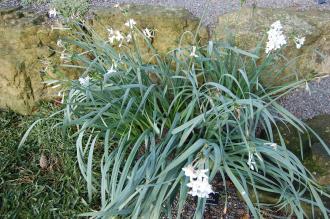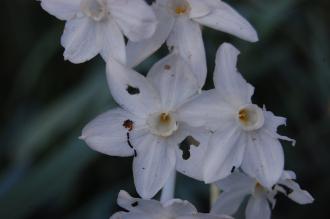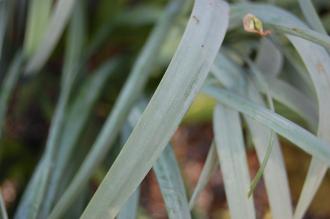
Narcissus papyraceus (30/11/14, Kew Gardens, London)
Position: Full sun
Flowering period: Winter to early spring
Soil: Moist, well drained
Eventual Height: 45cm
Eventual Spread: 10cm
Hardiness: 8a, 8b, 9a, 9b, 10a, 10b
Family: Amaryllidaceae
Narcissus papyraceus is a spring flowering perennial bulb. Its blue/ green leaves are strap like with entire margins, up to 35cm long and 15mm across. Its leaves emerge in winter and persist until spring, when they turn brown and wither. Its fragrant white flowers are trumpet shaped, up to 5cm across, appear in groups and are borne on slender, leafless stems. Its roots appear from an ovoid bulb which is up to 5cm in diameter.

Narcissus papyraceus Flower (30/11/14, Kew Gardens, London)
Narcissus papyraceus, commonly known as the Paperwhite, is native to the western Mediterranean, including Morocco Algeria, Portugal, Spain and Italy.
The etymological root of the binomial name Narcissus is the classical Latin name for the species and it is derived from the original Greek. It is perhaps an allusion to perceived narcotic properties, meaning ‘numb’. Other authorities believe it to be after Narcissus of Greek mythology, who stared at his own reflection so long in a pool of water he died of dehydration, the Narcissus plant was said to sprout from the spot where he died. Papyraceus is derived from the Greek papuros meaning ‘paper’.
The landscape architect may find Narcissus papyraceus useful for naturalising in areas of grass or planted as a fragrant addition to a herbaceous planting scheme.
Ecologically, Narcissus papyraceus flowers are attractive to some pollinating insects.

Narcissus papyraceus Leaf (30/11/14, Kew Gardens, London)
Narcissus papyraceus prefers moist, fertile, well-drained soils. It tolerates most pH of soil.
Narcissus papyraceus requires little maintenance. When naturalised in grass the leaves may be mown off once the leaves start to wither.


